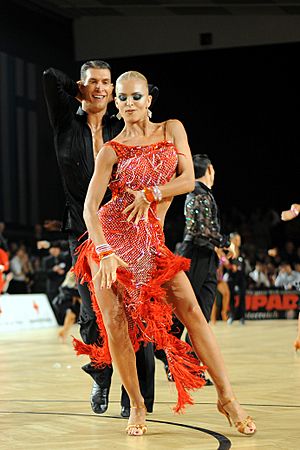Cha-cha-cha facts for kids

Dance competition in Austria
|
|
| Genre | Latin dance |
|---|---|
| Time signature | 4 4 |
| Year | 1950's |
| Origin | Cuba |
The cha-cha-cha (or cha-cha) is a lively dance from Cuba. People dance it to special cha-cha-cha music. This music was created by a Cuban musician named Enrique Jorrin in the early 1950s. The name "cha-cha-cha" sounds like the shuffling noise dancers make with their feet during two quick steps.
In the 1950s, Enrique Jorrín played violin with a band called Orquesta América. They played music like danzón in dance halls in Havana. Jorrín noticed that dancers sometimes struggled with the tricky rhythms of the danzón-mambo music. To make dancing easier, he started writing songs with a stronger beat. When his band played these new songs, dancers started adding a special "triple step" to their moves. This step made a "cha-cha-cha" sound, and that's how the dance got its name!
The basic steps of the cha-cha-cha are also found in older Afro-Cuban dances. These dances are part of the Santería religion. For example, a dance for the Orisha Ogun has a similar foot pattern. This means the cha-cha-cha probably got some of its moves from these older Cuban dances.
In 1953, Orquesta América released Jorrín's new songs. They quickly became very popular in Havana. Soon, everyone wanted to dance the cha-cha-cha. This dance craze spread quickly to Mexico City. By 1955, the cha-cha-cha was popular in Latin America, the United States, and Europe. It followed the success of the mambo, another popular dance from a few years before.
Contents
What is Cha-cha-cha Dance Like?
Cha-cha-cha is usually danced to real Cuban music. However, in dance competitions, you might hear it danced to Latin pop or Latin rock. The music for the international ballroom cha-cha-cha is fast and has a steady beat. It can sometimes have complex rhythms.
Different styles of cha-cha-cha exist. They can change where the "chasse" (a series of quick steps) fits into the music. The original Cuban and ballroom cha-cha-cha counts are "one, two, three, cha-cha." Sometimes, people count it differently, like "one, two, cha-cha-cha." This changes the timing of the dance.
Basic Steps in Ballroom Cha-cha-cha
In ballroom dancing, the main pattern starts with the lead dancer stepping forward with their left foot. They keep some weight on their right foot. Then, they shift their full weight to the right foot on the third beat.
The fourth beat is split into two parts. This is where the "cha-cha chasse" happens. The dancer takes a step to the side with the left foot. Then, the right foot moves close to the left foot. Finally, there's another step to the left with the left foot. The size of these steps can change depending on the dancer's style.
The partner does the opposite steps. They step back with their right foot. Then, they shift weight to their left foot. After that, they do a chasse with their right, left, and right feet. Each partner then repeats the steps the other person just did. This means the basic cha-cha-cha pattern takes two musical bars to complete.
Dancers usually start steps with the ball of their foot. Then, they lower their heel as they put their full weight on that foot. When they lift their foot, the heel comes up first, but the toe stays on the floor for a moment.
How Dancers Move Their Hips
In the traditional American Rhythm style, dancers create hip movement by bending and straightening their knees. However, in modern competitions, the technique is very similar to the international Latin style.
In the international Latin style, the leg with weight on it is almost always straight. The other leg bends, which makes the hips naturally move towards the weighted leg. When a dancer takes a step, the free leg straightens just before it gets weight. It stays straight until it is completely free of weight again.
Cha-cha-cha in Competitions
Cha-cha-cha is one of the five dances in the "Latin American" program for international ballroom dance competitions.
The modern dance style was developed in the 1950s by Pierre and Lavelle. Then, in the 1960s, Walter Laird and other top dancers helped shape it further. The basic steps taught today come from their work.
In general, the steps are kept small and compact. Dancers usually do not rise up and down during the dance. This is the modern ballroom technique for cha-cha-cha and other Latin dances.
For international ballroom competitions, the music for cha-cha-cha is played at a certain speed. The World Dance Council requires 30 bars per minute. The World DanceSport Federation requires 30-32 bars per minute.
Images for kids
See also
 In Spanish: Cha Cha Cha (desambiguación) para niños
In Spanish: Cha Cha Cha (desambiguación) para niños




